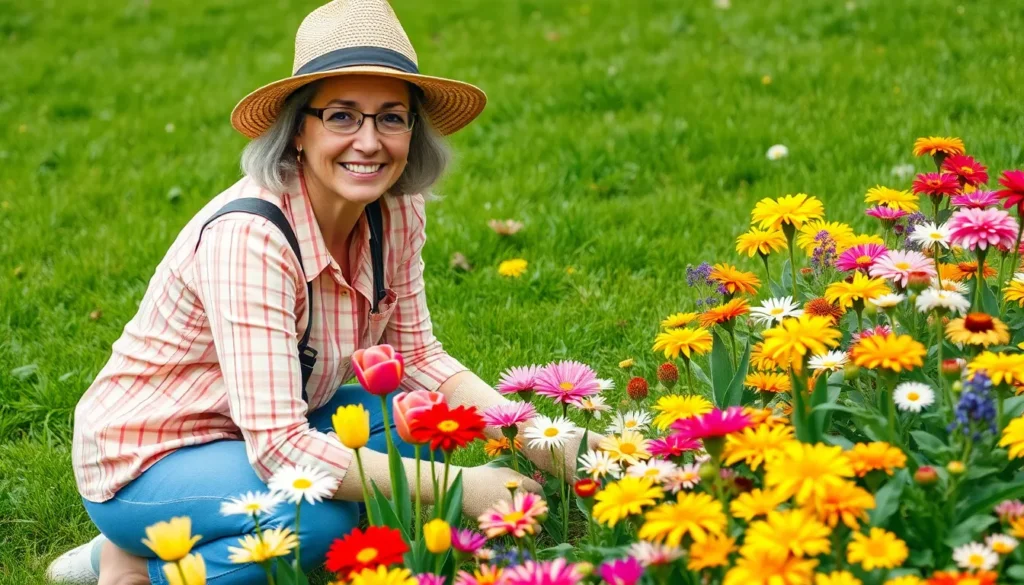Creating stunning flower beds transforms any outdoor space from ordinary to extraordinary. Whether you’re working with a sprawling backyard or a compact garden area we’ve got the inspiration you need to design beautiful blooms that’ll make your neighbors stop and stare.
We understand that planning the perfect flower bed can feel overwhelming with countless plant options colors and design possibilities. That’s why we’ve compiled proven flower bed ideas that work for every skill level and budget. From low-maintenance perennial borders to vibrant seasonal displays these creative concepts will help you achieve the garden of your dreams.
Ready to turn that empty patch of soil into a showstopping masterpiece? Let’s explore fresh flower bed designs that’ll boost your home’s curb appeal and create outdoor spaces you’ll love spending time in year after year.
Cottage Garden Flower Bed Ideas for a Romantic Look
Cottage gardens capture the essence of romance through their artfully chaotic beauty and timeless appeal. These enchanting flower bed designs create intimate outdoor spaces that feel both natural and carefully curated.
Mixed Perennials and Annuals
Layering different heights creates the signature cottage garden look that feels effortlessly romantic. We recommend planting tall delphiniums, hollyhocks, and foxgloves as backdrop plants, with medium height roses, peonies, and lavender filling the middle ground. Low growing sweet alyssum, creeping phlox, and cottage pinks cascade along the front edges.
Combining perennials with annuals ensures continuous blooms throughout the growing season. Perennial favorites like black eyed susans, coneflowers, and bee balm provide reliable structure, while annual additions such as cosmos, zinnias, and nasturtiums fill gaps with vibrant color. This mixed approach gives us flexibility to experiment with new varieties each year.
Selecting complementary color palettes enhances the romantic atmosphere of cottage style plantings. Soft pastels including blush pink roses, lavender catmint, and cream colored peonies create dreamy combinations, while deeper purples, blues, and whites add sophisticated contrast. We often include silver foliaged plants like lamb’s ear or artemisia to tie color schemes together beautifully.
Climbing Roses and Trellises
Installing sturdy support structures transforms vertical spaces into romantic focal points within cottage flower beds. Wooden arbors, wrought iron obelisks, and rustic trellises provide essential framework for climbing varieties to showcase their cascading blooms. We position these structures at bed corners, entry points, or as central anchors to create height variation.
Choosing fragrant climbing roses amplifies the sensory experience of cottage garden designs. Varieties like ‘Eden’, ‘New Dawn’, and ‘Zephirine Drouhin’ offer repeat blooming cycles with intoxicating scents that drift throughout the garden space. These roses pair beautifully with clematis vines, which can intertwine through the same support structures for extended flowering periods.
Training and pruning techniques ensure healthy growth and maximum bloom production on climbing varieties. We tie new growth horizontally along trellis supports to encourage flower bud formation, while removing dead or diseased canes promotes vigorous new shoots. Regular deadheading throughout the growing season keeps plants looking tidy and encourages additional flush cycles.
Stone Pathways and Borders
Creating meandering walkways adds structure while maintaining the informal charm characteristic of cottage gardens. Natural flagstone paths, brick walkways, or gravel trails guide visitors through flower bed displays without overwhelming the romantic aesthetic. We design curved routes that reveal new garden vistas at each turn, encouraging leisurely exploration.
Edging with natural materials defines planting areas while complementing the cottage garden’s organic feel. Weathered brick borders, fieldstone edging, or reclaimed limestone create permanent boundaries that age gracefully over time. These materials also provide excellent drainage along bed edges and prevent grass encroachment into planted areas.
Incorporating stepping stones allows access for maintenance tasks without compacting soil around delicate plantings. We space irregularly shaped stones 18 to 24 inches apart through wider beds, choosing materials that match existing hardscape elements. Creeping thyme, moss, or other low growing plants can soften the spaces between stones for a naturally integrated appearance.
Modern Minimalist Flower Bed Designs
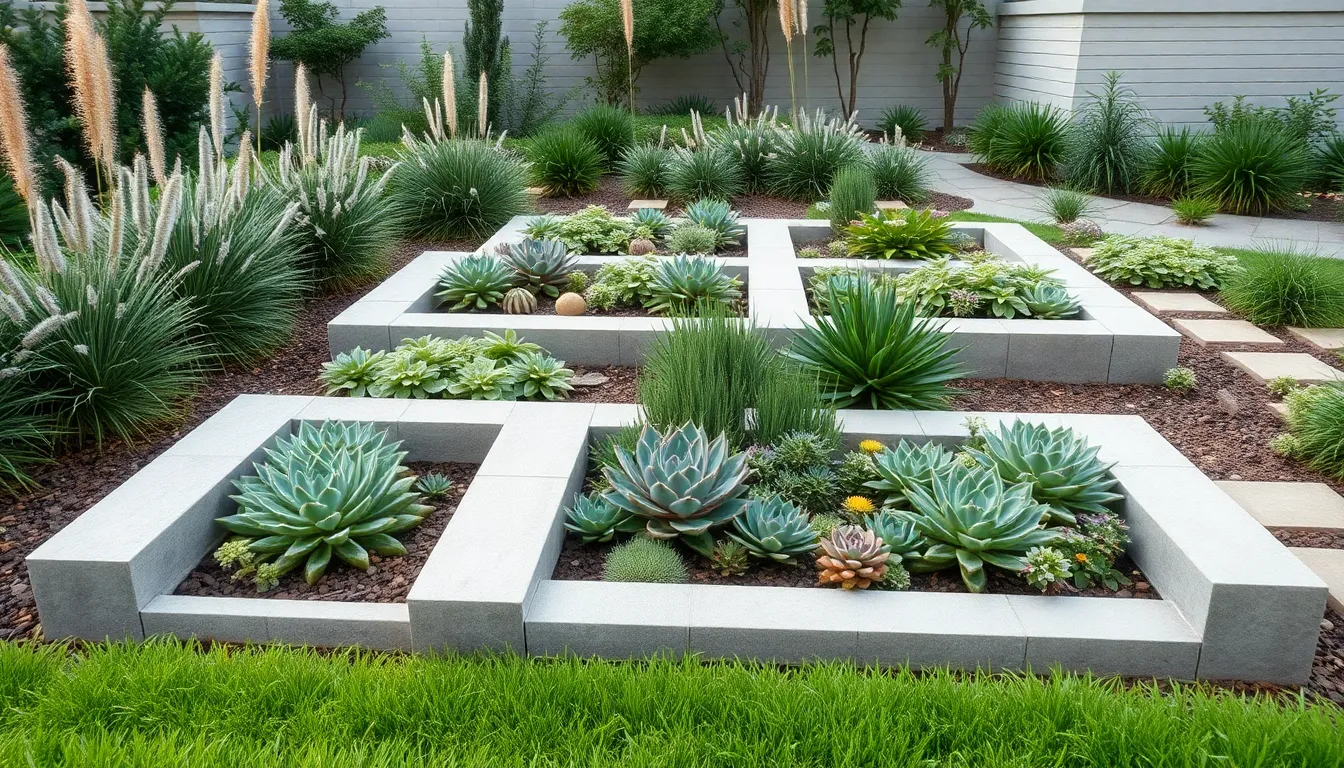
Modern minimalist flower bed designs offer a refreshing departure from elaborate cottage gardens by emphasizing simplicity and clean aesthetics. These contemporary beds focus on functionality while creating calming environments through reduced visual clutter.
Geometric Shapes and Clean Lines
Geometric shapes form the foundation of contemporary flower bed design. We recommend incorporating raised beds with angular borders or circular patterns to define your space and provide essential visual structure. Stone, wood, or metal edging materials help maintain those crisp edges that give minimalist beds their signature look.
Architectural elements like planters and retaining walls add sophisticated touches to your design. These hardscape features create clean transitions between different garden areas while maintaining the streamlined aesthetic that makes modern flower beds so appealing.
Monochromatic Color Schemes
Monochromatic color palettes create the unified look that defines minimalist flower bed designs. We suggest selecting plants with similar hues like whites, soft greens, or pale blues to establish a harmonious and serene environment throughout your space.
Subtle contrast can be achieved by introducing a single vibrant accent color or small statement plants. This approach maintains the simplicity you’re after while allowing for seasonal interest that keeps your flower bed captivating year round.
Ornamental Grasses and Succulents
Ornamental grasses provide the movement and architectural structure that minimalist designs require. These plants offer varying textures and heights while requiring minimal maintenance, making them perfect for busy homeowners who want beautiful results without constant upkeep.
Succulents complement grasses beautifully by adding unique geometric forms and reliable year round interest. We love how both plant types thrive in various climates while needing minimal watering and pruning, which aligns perfectly with the low maintenance philosophy of modern minimalist gardening.
Raised Flower Bed Ideas for Better Drainage
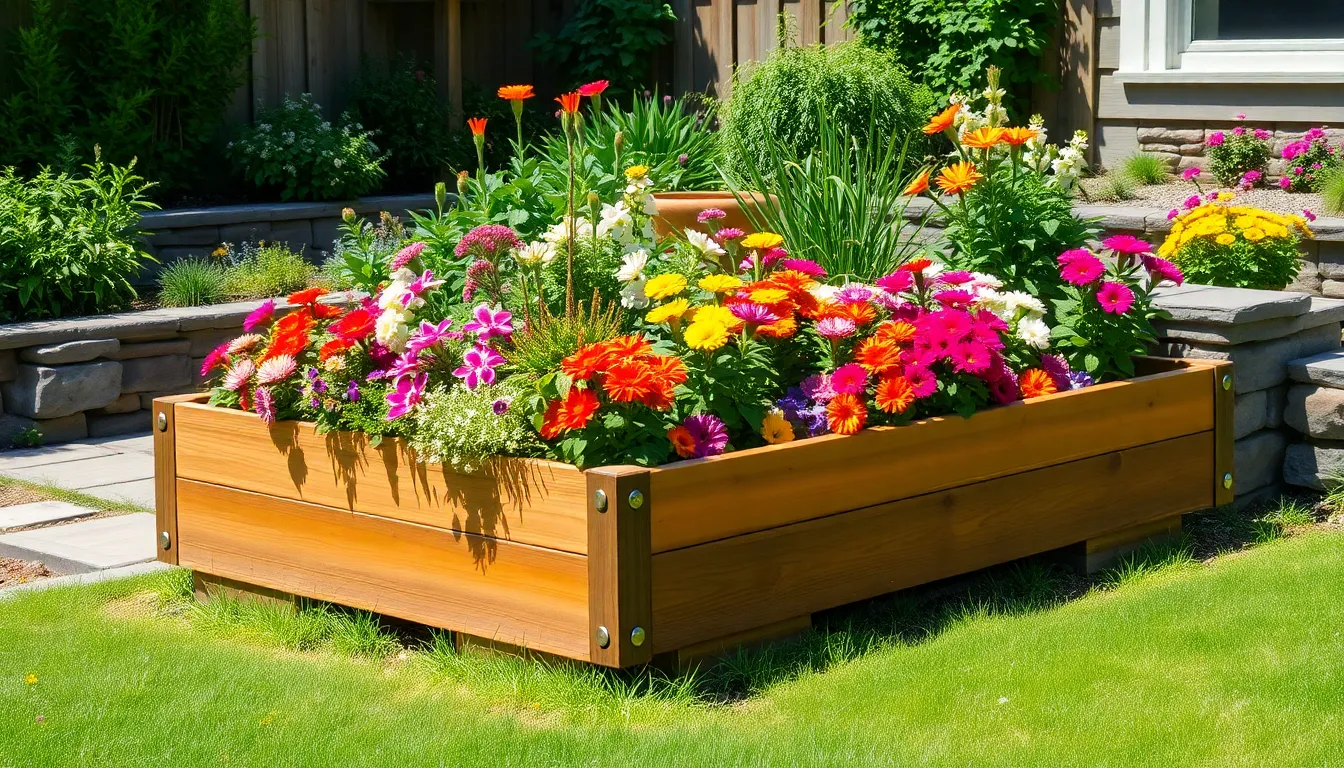
Proper drainage transforms struggling gardens into thriving landscapes. We’ve gathered the most effective raised flower bed answers that eliminate waterlogged soil while creating stunning garden features.
Wooden Box Planters
Wooden box planters offer exceptional drainage control for flower bed designs. These versatile structures elevate plants above ground level, allowing excess water to flow away naturally from root systems. Cedar and redwood materials resist rot effectively, providing years of reliable performance without chemical treatments.
Building rectangular or square wooden planters creates defined growing spaces with consistent drainage patterns. We recommend installing drainage holes every 6-8 inches along the bottom boards to prevent water accumulation. Treated lumber options extend planter lifespan significantly, though natural wood varieties blend seamlessly with organic garden aesthetics.
Stone and Brick Raised Borders
Stone and brick structures deliver superior water management through their naturally porous composition. These materials absorb excess moisture while allowing air circulation around plant roots, preventing the soggy conditions that harm flower bed health. Natural stone varieties like fieldstone or limestone create rustic borders that complement cottage garden styles.
Dry-stacked stone walls offer flexibility for drainage adjustments, while mortared installations provide permanent answers for formal garden designs. Brick raised borders work particularly well in urban settings, matching existing hardscape elements while solving drainage challenges. Both materials add thermal mass that moderates soil temperature fluctuations throughout growing seasons.
Tiered Garden Levels
Tiered garden systems manage water flow through strategic elevation changes that prevent pooling. Each level channels excess water to lower tiers, creating a natural drainage cascade that keeps all planting areas properly moistened without oversaturation. Terraced designs work especially well on sloped terrain where water runoff creates erosion problems.
Constructing multiple levels allows for varied plant selections based on moisture preferences. We position water-loving plants at lower tiers where drainage naturally collects, while drought-tolerant species thrive in upper levels with faster drainage. Retaining walls between tiers can incorporate built-in drainage systems like weep holes or French drains for enhanced water management.
Shade Flower Bed Ideas for Low-Light Areas
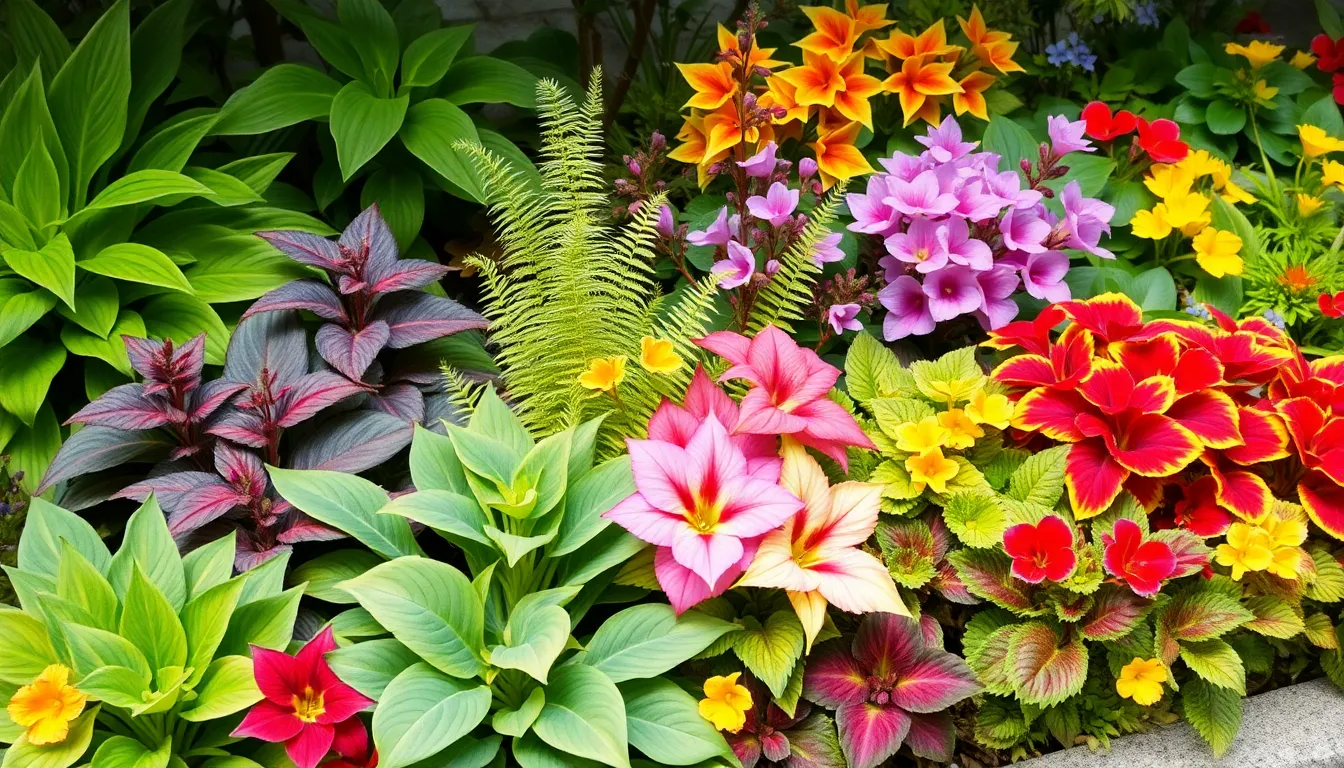
Creating beautiful flower beds in shaded areas doesn’t mean sacrificing vibrant colors or lush textures. We’ll explore proven plant combinations that thrive in low light conditions while adding visual appeal to your garden.
Hostas and Ferns
Hostas transform shaded spaces with their versatile foliage patterns and impressive range of sizes. These reliable perennials offer textural interest through their broad leaves, which come in various color combinations from solid green to variegated yellow and white patterns. We recommend pairing different hosta varieties to create layered compositions that maintain visual interest throughout the growing season.
Ferns bring delicate, lacy textures that complement the bold foliage of hostas perfectly. Their natural preference for moist, shaded environments makes them ideal companions for creating lush undergrowth effects. We’ve found that combining different fern species like Japanese painted ferns, Christmas ferns, and royal ferns creates beautiful textural contrasts while maintaining the cohesive forest floor aesthetic.
Begonias and Impatiens
Begonias provide continuous blooms in shade conditions where many flowering plants struggle. Their shade tolerance combined with vibrant flower colors makes them excellent choices for containers and hanging baskets in low light areas. We particularly appreciate wax begonias and tuberous begonias for their reliable performance and diverse color options including pink, red, white, and coral varieties.
Impatiens rank as top performers for shade flower beds, blooming continuously from late spring until frost arrives. These versatile annuals thrive in rich, well-drained soil and offer an impressive color palette that includes traditional varieties and newer cultivars. We recommend New Guinea impatiens for slightly brighter shade areas and standard impatiens for deeper shade locations.
Colorful Foliage Plants
Foliage plants deliver vibrant colors without depending on seasonal blooms for visual impact. Coleus leads our recommendations with its spectacular leaf patterns in burgundy, lime green, pink, and purple combinations that create stunning displays throughout the growing season. We’ve successfully used coleus as both border plants and focal points in shade garden designs.
Heuchera and caladium round out our essential colorful foliage selections for shade beds. Heuchera offers year round interest with its coral bell flowers and colorful leaves in shades of purple, silver, and chartreuse. Caladium provides tropical flair with heart shaped leaves in striking combinations of pink, white, red, and green patterns that brighten even the darkest garden corners.
Small Space Flower Bed Ideas for Compact Gardens

Working with limited space doesn’t mean we have to sacrifice the beauty of a well-designed flower bed. Smart planning techniques help us create stunning displays that maximize every square foot of our compact gardens.
Vertical Garden Walls
Trellises and arbors transform our flower beds by creating upward growing space that adds visual interest without consuming precious ground area. We can train climbing roses, clematis, or morning glories up these structures to create living walls of color and fragrance.
Building planters directly onto existing walls gives us additional planting space while maintaining our garden’s footprint. Pre-made wall planters offer a convenient solution that we can install quickly to establish vertical growing areas for annuals like petunias and begonias.
Hanging baskets suspended at different heights create layered displays that draw the eye upward while freeing up floor space for other plants. We recommend combining trailing varieties like ivy geraniums with upright flowers such as calibrachoa to achieve balanced compositions that bloom continuously throughout the season.
Container Flower Arrangements
Mixing different container sizes and shapes creates visually appealing arrangements that we can rearrange seasonally to refresh our garden’s appearance. Large planters serve as anchor points while smaller pots fill gaps and add textural variety to our displays.
Themed containers that match our garden’s overall style help create cohesive designs whether we prefer vintage galvanized buckets or sleek modern ceramics. Grouping containers of similar materials but varying sizes creates professional-looking arrangements that complement our existing industry features.
Incorporating trailing plants like petunias and bacopa allows flowers to spill gracefully over container edges, creating natural connections between different planted areas. These cascading elements soften hard edges while maximizing our planting space through multi-level growing techniques.
Corner and Border Plantings
Planting flowers along fence lines creates natural privacy screens while adding color to previously unused areas of our compact gardens. We position taller plants like hollyhocks and delphiniums at the back with shorter annuals such as marigolds and alyssum in front for layered visual impact.
Using unique edging materials like natural stone or decorative brick helps define our flower bed boundaries while adding architectural interest to small spaces. These borders prevent soil spillage and create clean lines that make our compact gardens appear larger and more organized.
Corner planters strategically placed in overlooked areas maximize our available growing space while adding beauty to transitional zones between different garden sections. We fill these spaces with seasonal favorites like pansies in spring or chrysanthemums in fall to maintain year-round interest in our compact flower beds.
Seasonal Flower Bed Ideas for Year-Round Color
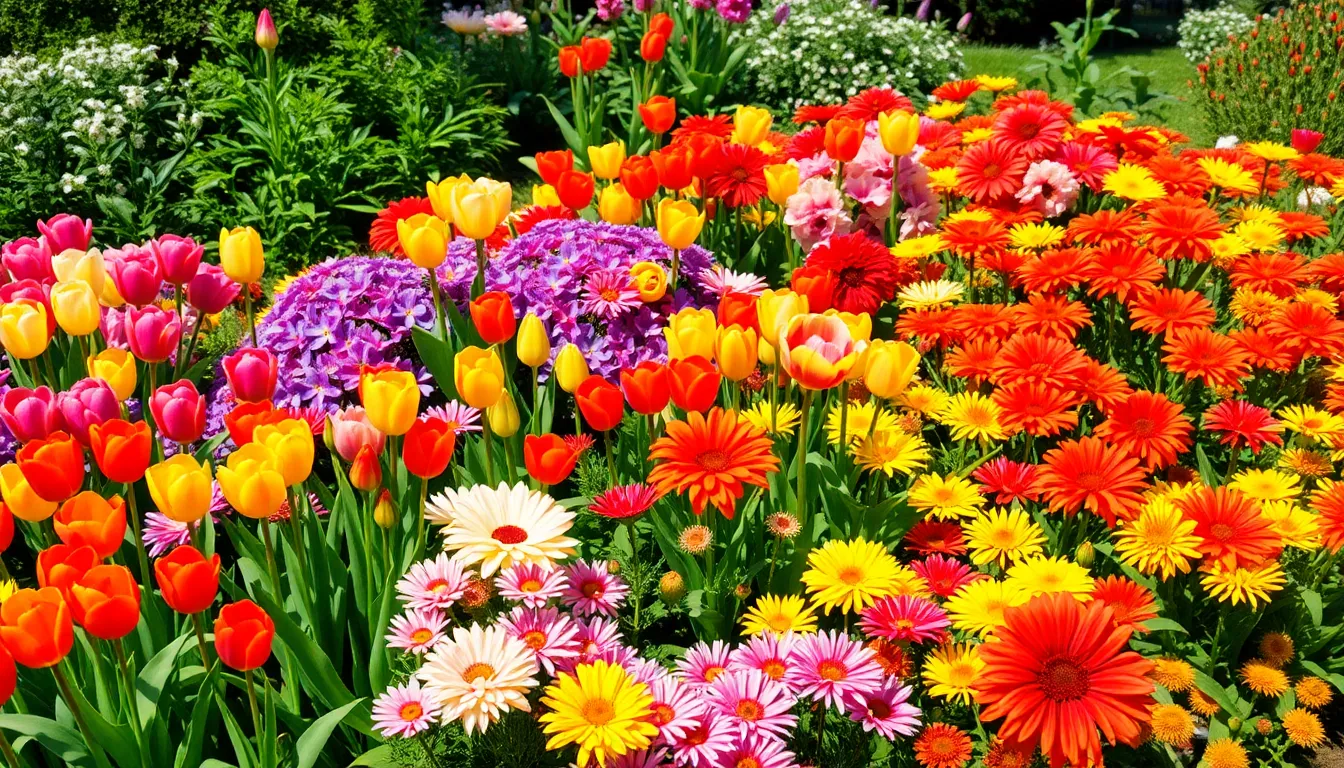
Creating seasonal flower beds ensures your garden maintains vibrant displays throughout every season. We’ll explore strategic planting combinations that deliver continuous color from spring’s first blooms through winter’s architectural elements.
Spring Bulb Gardens
Spring bulb gardens transform landscapes with explosive early season color. Tulips, daffodils, hyacinths, and crocuses create the foundation for spectacular spring displays that emerge when winter finally releases its grip. We recommend planting these bulbs in distinct clusters or geometric patterns to maximize visual impact rather than scattering them randomly throughout beds.
Design strategies enhance bulb garden effectiveness significantly. Incorporating early blooming perennials like bleeding hearts and pansies alongside traditional bulbs extends the color season and fills gaps between bulb plantings. These companion plants provide additional texture and hues that complement the bold colors of spring bulbs.
Clustering techniques create more dramatic visual effects. Groups of 15-20 bulbs of the same variety produce stronger color statements than single bulbs scattered across wide areas. This approach also allows for easier maintenance and more predictable bloom timing across your spring garden displays.
Summer Perennial Displays
Summer perennial displays provide the backbone of sustained warm weather color. Daylilies, lilac, roses, weigela, and butterfly bushes form reliable foundations that return year after year with minimal replanting efforts. These established perennials create structure around which we can build layered summer gardens.
Layered planting approaches maximize summer garden impact. Mixing tall background plants with shorter foreground specimens creates depth and visual interest throughout the growing season. Adding annuals like marigolds and snapdragons between perennial groupings introduces fresh color combinations and fills seasonal gaps.
Succession blooming extends summer color duration. Selecting plants with different bloom times ensures continuous color from early summer through fall’s first frost. This strategic timing prevents the common problem of gardens that peak in early summer then fade for the remainder of the season.
Fall Chrysanthemum Arrangements
Fall chrysanthemum arrangements anchor autumn garden displays with rich seasonal colors. Chrysanthemums serve as traditional fall staples, but we enhance these displays by incorporating mums, blue sage, and fall blooming bulbs for extended interest. These combinations create robust autumn gardens that celebrate the season’s unique palette.
Companion planting elevates fall flower bed designs. Pairing chrysanthemums with ornamental kales and cabbages produces vibrant displays that combine flowering plants with colorful foliage elements. This approach adds textural variety while maintaining the warm color schemes that make fall gardens so appealing.
Warm color palettes create cozy autumn atmospheres. Using combinations of deep oranges, rich yellows, burgundy reds, and golden browns throughout fall arrangements establishes the comfortable feeling associated with harvest season. These color choices work together to create garden spaces that feel welcoming as temperatures begin to drop.
Low-Maintenance Flower Bed Ideas for Busy Gardeners
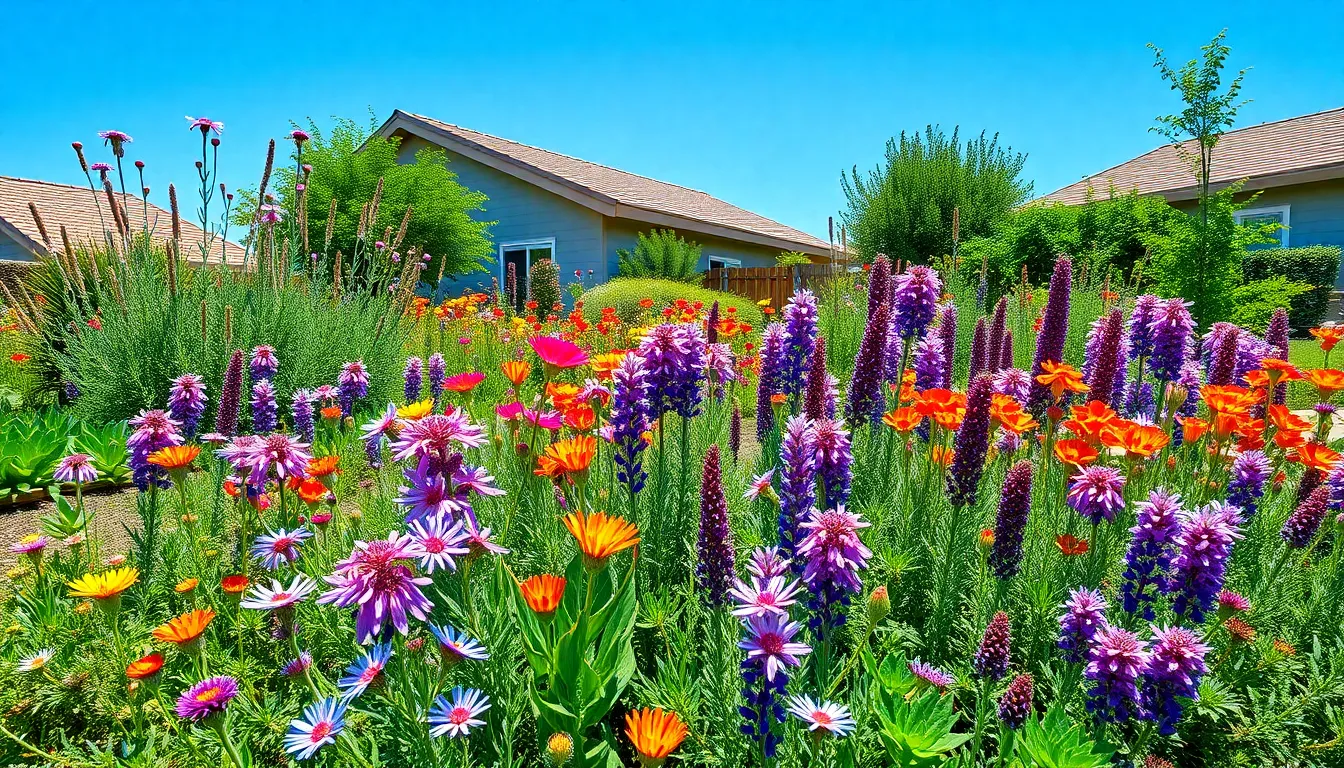
We understand that maintaining beautiful flower beds shouldn’t consume all your free time. Creating low maintenance gardens with the right plant selections lets you enjoy stunning blooms without constant upkeep.
Native Plant Selections
Choosing native plants significantly reduces your gardening workload while supporting local ecosystems. Native flowers and grasses adapt naturally to your area’s climate conditions, requiring less water, fertilizer, and pest management interventions. Cornflowers create butterfly havens in your garden while producing vibrant blue blooms throughout the season. Salvia varieties attract hummingbirds with their tubular flowers and thrive in various soil conditions with minimal care. Local plant species eliminate concerns about invasive growth patterns and provide natural resistance to regional pests and diseases.
Drought Tolerant Varieties
Selecting drought resistant plants creates resilient flower beds that flourish with minimal watering schedules. Russian sage produces silvery foliage and purple flower spikes while tolerating extended dry periods. Euphorbia varieties offer unique textures and colors with their succulent like characteristics that store water efficiently. Sedum creates stunning ground cover displays with thick, fleshy leaves that require virtually no supplemental watering once established. These hardy selections develop deep root systems that access groundwater naturally, making them perfect for water restricted areas or busy gardeners.
Self Seeding Flower Options
Self seeding flowers provide continuous color displays with minimal replanting efforts from gardeners. Cosmos scatter seeds naturally and return each year with delicate, daisy like blooms in pink, white, and orange varieties. Alyssum carpets garden areas with tiny, fragrant flowers while reseeding reliably for ongoing coverage. Annual varieties like marigolds and zinnias drop seeds that germinate the following spring, creating surprise color combinations throughout your beds. We recommend allowing some flowers to go to seed rather than deadheading everything, ensuring natural propagation for future seasons.
Creative Border Flower Bed Ideas
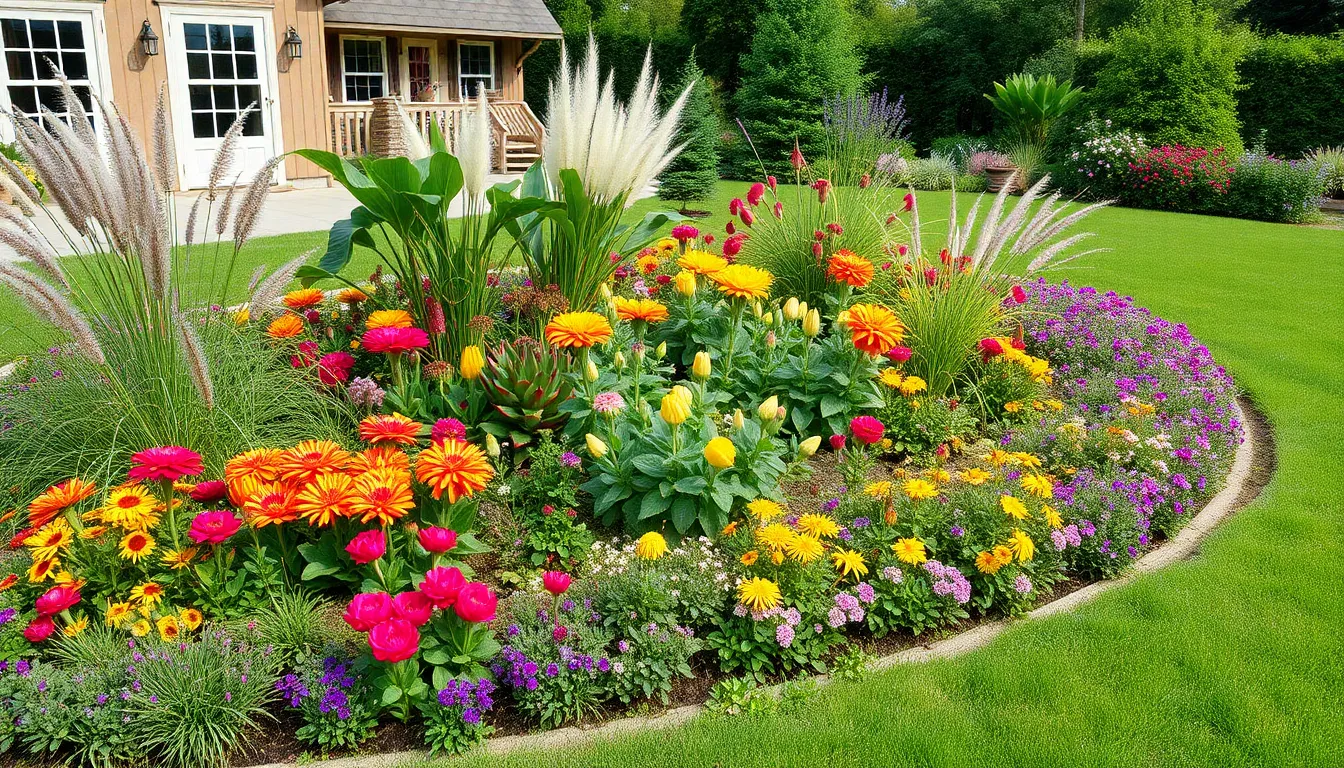
Transforming your garden’s perimeter opens up countless possibilities for stunning displays that frame your entire industry. Creative border designs can establish clear boundaries while adding visual interest that complements your home’s architecture.
Curved and Flowing Designs
Curved flower bed borders create natural, organic shapes that soften harsh industry lines and blend seamlessly with your outdoor environment. These flowing designs mimic nature’s contours, using gentle sweeping curves instead of rigid geometric patterns to establish a more relaxed garden atmosphere.
We recommend combining flowers, shrubs, and groundcovers in curved arrangements to maintain that flowing appearance throughout the growing season. Plant taller specimens like ornamental grasses toward the back of curved borders, transitioning to medium height perennials in the middle, and finishing with low growing annuals along the front edge.
Designing curved beds requires careful planning to ensure smooth, natural looking lines that complement your industry’s existing features. Use a garden hose to outline potential curves before digging, adjusting the shape until it feels balanced and proportional to your space.
Island Beds in Lawn Areas
Island beds create dramatic focal points within open lawn spaces, breaking up large expanses of grass while adding color and texture to otherwise monotonous areas. Strategic placement of these standalone gardens can guide foot traffic patterns and create natural gathering spaces for outdoor entertaining.
Central focal points anchor island bed designs, using elements like large trees, decorative statues, or water features as the primary attraction. Surround these centerpieces with flowering plants that complement the focal element’s scale and style, creating layered displays that look intentional from every viewing angle.
We suggest positioning island beds where they’ll receive adequate sunlight while remaining accessible for maintenance tasks. Consider sight lines from your home’s windows and outdoor seating areas to maximize the visual impact of these standalone garden features.
Multiple island beds can work together to create rhythm and movement across larger properties, using similar plant palettes or design elements to maintain visual cohesion while avoiding overcrowding.
Edging Materials and Techniques
Weathered wood edging brings rustic cottage charm to flower bed borders, using materials like cedar planks or reclaimed barn wood to define planting areas. Field stone edging offers another natural option that complements both cottage and contemporary garden styles while providing excellent drainage along bed perimeters.
Creative edging materials can transform ordinary flower beds into distinctive garden features that reflect your personal style preferences. Brick edging creates clean, traditional lines that work well with colonial and Victorian home architecture, while metal edging offers sleek, modern definition for contemporary landscapes.
We recommend exploring recycled materials for unique edging answers that add character while supporting environmental sustainability. Old wine bottles, vintage tiles, or repurposed concrete blocks can create one of a kind borders that become conversation starters for garden visitors.
Professional installation techniques ensure edging materials remain stable and attractive over time, requiring proper excavation depth and secure anchoring methods. Consider the maintenance requirements of different edging options, as some materials need periodic cleaning or replacement to maintain their appearance.
Color-Themed Flower Bed Ideas
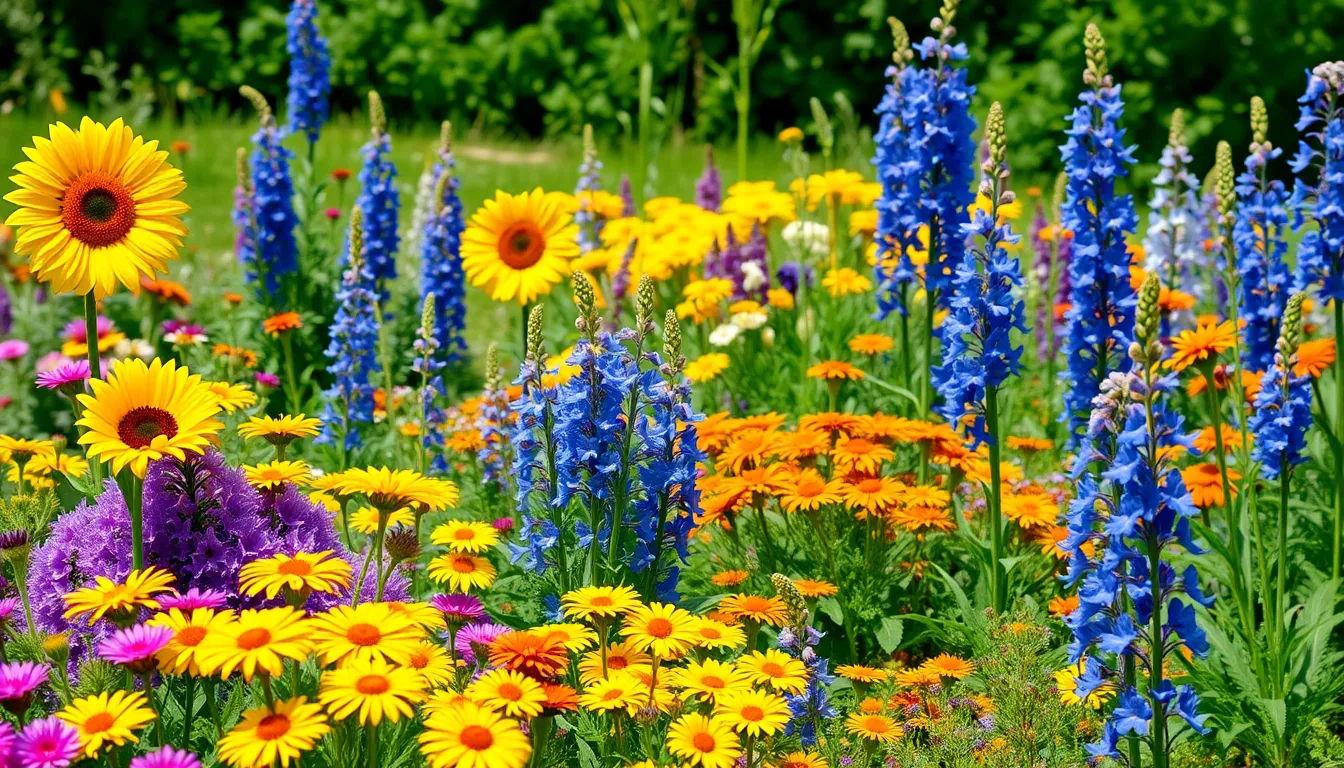
Color themes transform ordinary flower beds into cohesive, visually stunning displays that create lasting impressions. Strategic color planning ensures your garden achieves the desired mood and aesthetic appeal.
Monochromatic Gardens
Monochromatic designs focus on different shades of a single color to create harmonious and unified spaces. These gardens work exceptionally well in small areas since they make compact spaces appear larger while maintaining visual coherence. Purple themed beds showcase this approach beautifully by combining lavender’s soft tones with deeper plum varieties for layered depth.
Single color schemes eliminate visual chaos while allowing you to explore diverse textures within your chosen palette. Light purple catmint pairs elegantly with darker purple salvia to create sophisticated contrasts without breaking the monochromatic rule. Various flower shapes and sizes within the same color family add interest while maintaining the calming effect of unified hues.
Complementary Color Combinations
Complementary colors sit opposite each other on the color wheel and create vibrant, ever-changing garden displays. These high contrast pairings energize outdoor spaces through their natural visual tension and dramatic appeal. Bright yellow sunflowers paired with deep violet flowers exemplify this principle by creating bold, eye catching combinations that draw attention from across the yard.
Orange marigolds complement blue delphiniums perfectly while red roses create stunning contrasts with green foliage backdrops. These opposing color relationships intensify each hue’s appearance and create gardens that feel alive with energy. Strategic placement of complementary pairs throughout your bed ensures balanced visual weight without overwhelming the space.
Rainbow Flower Arrangements
Rainbow arrangements incorporate multiple colors to create lively, cheerful displays that celebrate nature’s full spectrum. These diverse plantings work best when organized thoughtfully rather than randomly scattered throughout the bed. Warm colors like yellow, orange, and red naturally draw the eye and add energetic focal points to your garden design.
Sequential color placement mimics natural rainbow progressions while creating smooth visual transitions between different hues. Cool colors including blues, purples, and greens provide calming balance to offset the excitement of warmer tones. Mixed color beds require careful attention to bloom times ensuring continuous color throughout the growing season rather than brief bursts followed by gaps.
Budget-Friendly Flower Bed Ideas
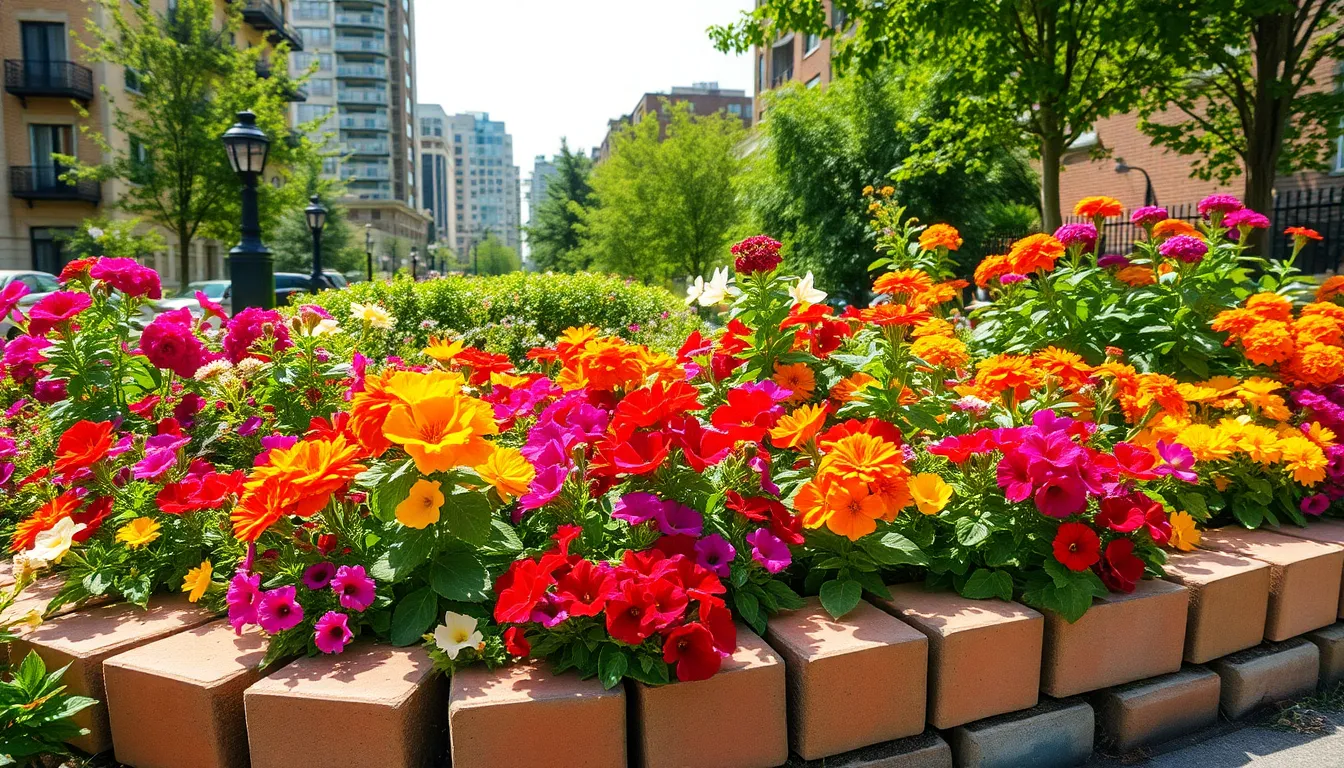
Creating stunning flower beds doesn’t require a massive budget when you carry out smart strategies and cost-effective techniques. We’ll explore proven methods that maximize your garden’s impact while minimizing expenses.
Seed Starting and Propagation
Starting flowers from seeds provides an incredibly cost-effective method for filling large flower beds with vibrant blooms. Seeds cost significantly less than mature plants and allow us to grow dozens of plants for the price of just a few nursery specimens. We recommend beginning seeds indoors before the growing season to ensure strong, healthy seedlings that’ll thrive once transplanted outdoors.
Wildflower seed mixes offer exceptional value since they contain various hardy species that require minimal maintenance throughout the growing season. Popular wildflower varieties like petunias, begonias, and marigolds provide continuous color while attracting beneficial wildlife to our gardens. Propagating existing plants through cuttings or layering techniques allows us to expand flower beds at absolutely no cost while maintaining our favorite plant varieties.
Perennial Divisions and Swaps
Dividing mature perennials serves dual purposes by rejuvenating existing plants while providing new material for expanding our flower beds. We can split overgrown perennials in spring or fall, creating multiple plants from a single parent specimen. This process not only saves money but also maintains healthy plant populations throughout our gardens.
Trading plant divisions with neighbors creates opportunities to increase variety without spending any money on new specimens. Local plant swap groups and community gardening organizations help these exchanges, helping us discover new varieties while sharing our own successful plants. We’ve found that participating in these swaps builds relationships within the gardening community while supporting biodiversity in our local landscapes.
DIY Edging and Mulching
Creating attractive flower bed borders using recycled materials like old bricks, stones, or wooden boards defines our planting areas while controlling weed growth effectively. We can repurpose materials from construction projects, old walkways, or even broken concrete to create unique, personalized edging that costs virtually nothing. Gravel serves as another inexpensive option for creating pathways or defining bed boundaries with clean, professional-looking results.
Accessing free or low-cost mulch through community programs significantly reduces our gardening expenses while improving soil health. Municipal compost piles and tree trimming services often provide free mulch to residents, helping us conserve water and add valuable nutrients to our soil. We’ve discovered that combining DIY edging with strategic mulching improves both the aesthetic and functional quality of our flower beds while staying within tight budget constraints.
Conclusion
We’ve shown you that creating beautiful flower beds doesn’t require extensive gardening experience or unlimited resources. Whether you’re working with a tiny balcony or sprawling backyard these ideas prove that every space has potential for stunning displays.
The key is matching your design choices to your lifestyle and environment. Busy schedules call for low-maintenance natives while shaded areas thrive with hostas and colorful foliage plants. Your budget shouldn’t limit your creativity either – seed starting and plant swapping can fill beds without very costly.
Most importantly remember that successful flower beds evolve over time. Start with one or two ideas that excite you most then build upon your successes. Your outdoor space will reward your efforts with seasons of beauty and the satisfaction that comes from creating something truly special with your own hands.
Frequently Asked Questions
What are the key elements of a cottage garden flower bed?
Cottage garden flower beds feature artfully chaotic beauty with layered plantings of mixed perennials and annuals. Key elements include complementary color palettes, climbing roses with trellises for vertical interest, and stone pathways or borders to maintain informal charm while guiding visitors through the space.
How do I create a modern minimalist flower bed design?
Focus on geometric shapes with clean lines using raised beds, circular patterns, or angular borders. Use monochromatic color schemes with subtle accent colors, and incorporate ornamental grasses and succulents for architectural interest and low maintenance requirements.
What are the benefits of raised flower beds?
Raised flower beds improve drainage significantly, helping struggling gardens thrive. They elevate plants above ground level for better water flow, can be built with durable materials like cedar or stone, and allow for tiered systems that manage water flow through elevation changes.
Which plants work best for shade flower beds?
Shade flower beds thrive with hostas and ferns for textural interest, begonias and impatiens for continuous blooms, and colorful foliage plants like coleus, heuchera, and caladium. These plants deliver vibrant colors and lush effects without requiring full sunlight.
How can I maximize small space flower beds?
Use vertical garden walls with trellises, hanging baskets, and container arrangements to maximize space. Focus on corner and border plantings for color and privacy, and use unique edging materials to define boundaries and enhance organization in compact areas.
What are the best low-maintenance flower bed options?
Choose native plants that require less water and care, drought-tolerant varieties like Russian sage and sedum, and self-seeding flowers like cosmos and alyssum. These options provide continuous color with minimal upkeep while supporting local ecosystems.
How do I ensure year-round color in my flower beds?
Plant spring bulbs like tulips and daffodils in clusters, create summer perennial displays with succession planting, and use fall arrangements with chrysanthemums and ornamental kales. Layer different plants to ensure continuous blooms throughout all seasons.
What are some budget-friendly flower bed ideas?
Start flowers from seeds, use wildflower seed mixes, and propagate existing plants through cuttings. Divide mature perennials to create new plants, trade divisions with neighbors, and use DIY edging with recycled materials to minimize costs while maximizing impact.
How do I create effective color-themed flower beds?
Use monochromatic gardens with different shades of one color for harmony, or try complementary color combinations for vibrant contrasts. For rainbow arrangements, incorporate multiple colors thoughtfully while ensuring continuous blooms throughout the growing season.
What edging materials work best for flower bed borders?
Consider weathered wood for rustic appeal, field stone for natural looks, or recycled materials for eco-friendly options. Choose materials that complement your garden style and ensure professional installation techniques for durability and long-lasting aesthetic appeal.

